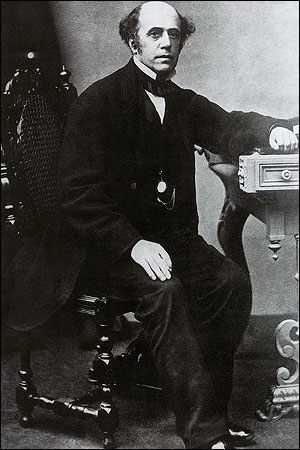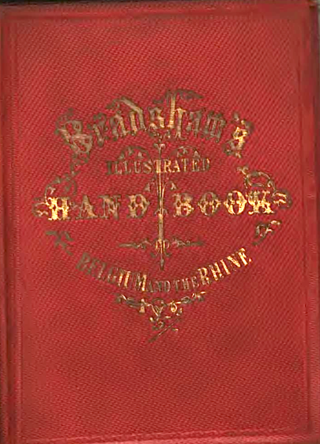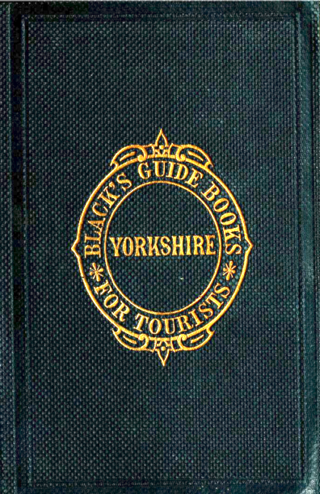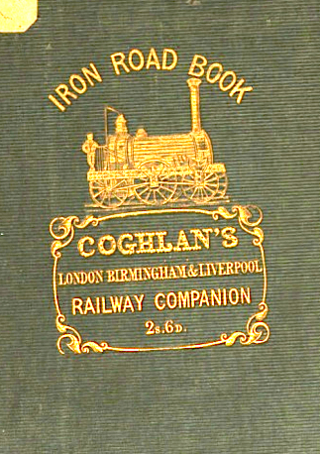
Thomas Cook was an English businessman. He is best known for founding the travel agency Thomas Cook & Son. He was also one of the initial developers of the "package tour" including travel, accommodations, and the like.

Thomas Cook & Son, originally simply Thomas Cook, was a company founded by Thomas Cook, a cabinet-maker, in 1841 to carry temperance supporters by railway between the cities of Leicester, Nottingham, Derby and Birmingham. In 1851, Cook arranged transport to the Great Exhibition of 1851. He organised his first tours to Europe in 1855 and to the United States in 1866.

Bradshaw's was a series of railway timetables and travel guide books published by W.J. Adams and later Henry Blacklock, both of London. They are named after founder George Bradshaw, who produced his first timetable in October 1839. Although Bradshaw died in 1853, the range of titles bearing his name continued to expand for the remainder of the 19th and early part of the 20th century, covering at various times Continental Europe, India, Australia and New Zealand, as well as parts of the Middle-East. They survived until May 1961, when the final monthly edition of the British guide was produced. The British and Continental guides were referred to extensively by presenter Michael Portillo in his multiple television series.
The following is a timeline of the history of the city of Damascus, Syria.

Murray's Handbooks for Travellers were travel guide books published in London by John Murray beginning in 1836. The series covered tourist destinations in Europe and parts of Asia and northern Africa. According to scholar James Buzard, the Murray style "exemplified the exhaustive rational planning that was as much an ideal of the emerging tourist industry as it was of British commercial and industrial organization generally." The guidebooks became popular enough to appear in works of fiction such as Charles Lever's Dodd Family Abroad. After 1915 the series continued as the Blue Guides and the familiar gold gilted red Murrays Handbooks published by John Murray London including the long running Handbook to India, Pakistan, Ceylon & Burma which concluded with the 21st edition in 1968 before changing from the original format of 1836 to a more modern paperback edition of 1975.
The following is a timeline of the history of Düsseldorf, Germany.
The following is a timeline of the history of Luxembourg City, Luxembourg.
The following is a timeline of the history of the municipality of Antwerp, Belgium.

Black's Guides were travel guide books published by the Adam and Charles Black firm of Edinburgh beginning in 1839. The series' style tended towards the "colloquial, with fewer cultural pretensions" than its leading competitor Baedeker Guides. Contributors included David T. Ansted, Charles Bertram Black, and A.R. Hope Moncrieff.

Harper's Hand-Book for Travellers (est.1862) was a series of travel guide books published by Harper & Brothers of New York. Each annual edition contained information for tourists in Europe and parts of the Middle East. The "indefatigable" William Pembroke Fetridge wrote most of the guides from 1862 until at least 1885. In its day the Harper's Hand-Book competed with popular guides such as Baedeker, Bradshaw's, and Murray's. In 1867 critic William Dean Howells found Harper's Hand-Book "chatty and sociable." Readers included Lucy Baird, daughter of Spencer F. Baird.

Appletons' travel guide books were published by D. Appleton & Company of New York. The firm's series of guides to railway travel in the United States began in the 1840s. Soon after it issued additional series of handbooks for tourists in the United States, Europe, Canada and Latin America.

Coghlan's Guides were a series of travel guide books to Europe written by Francis Coghlan in the mid-19th century.
Samuel Leigh was a bookseller and publisher in 19th century London. His office stood on the Strand. From around 1806 to 1814 he conducted business with James Mathews in the partnership of "Mathews and Leigh." He also married Mathews' daughter. Leigh died by his own hand in 1831.

The following is a timeline of the history of the city of Dublin, Ireland.

Ward Lock travel guides or Red Guides (1870s–1970s) were tourist guide books to the British Isles and continental Europe published by Ward, Lock & Co. of London. The firm proclaimed them "amusing and readable" and the "cheapest and most trustworthy guides." To other readers the books were promotional and "rarely critical." Compared to similar late 19th century series such as Methuen & Co.'s Little Guides, the Ward Lock guides emphasized "travel practicalities."

The following is a timeline of the history of the city of Aachen, Germany.
The following is a timeline of the history of the municipality of Leuven, Belgium.
The following is a list of works about Amsterdam, Netherlands.
The following is a list of works about Philadelphia, Pennsylvania, U.S.










